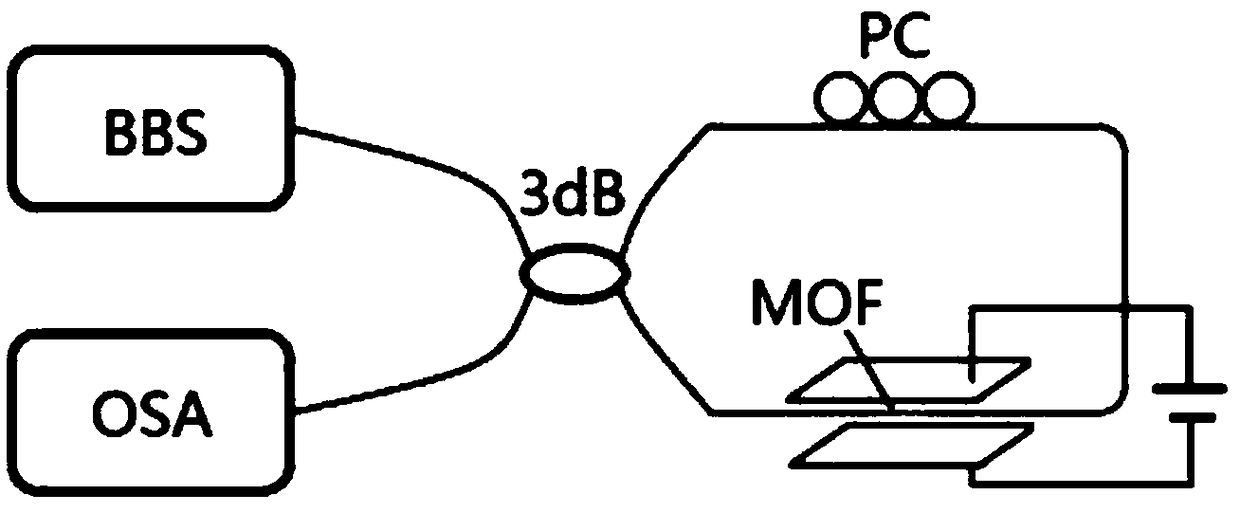Sagnac interference temperature sensor based on liquid crystal-filled microstructure optical fiber
A technology of microstructured optical fiber and temperature sensor, which is applied in the direction of thermometers, thermometers, instruments, etc. with physical/chemical changes, can solve the problem that the interference wave trough wavelength and temperature do not meet the linear relationship, the average sensitivity of temperature measurement is low, and the interference of microstructured optical fibers is unfavorable. Sensing and other issues, to achieve the effect of a simple filling method
- Summary
- Abstract
- Description
- Claims
- Application Information
AI Technical Summary
Problems solved by technology
Method used
Image
Examples
Embodiment 1
[0031] exist figure 1 In the Sagnac interferometer optical path schematic diagram of the shown embodiment 1 of the present invention, the broadband laser source BBS outputs laser light to the 3dB coupler, and the 3dB coupler divides the light into two beams of linearly polarized light that propagate clockwise and counterclockwise, and the polarization controller PC rotates the polarization of two beams of linearly polarized light by 90 degrees. The SF57 microstructure optical fiber MOF completely filled with nematic liquid crystal E7 is connected to the Sagnac interference optical path. The parallel plate electrodes on both sides of the microstructure optical fiber and its power supply provide an electric field to make the liquid crystal molecules Oriented in the direction of the electric field, the spectrometer OSA measures the interference spectrum output by the 3dB coupler. exist figure 2In the schematic diagram of the structure of the microstructured optical fiber shown,...
Embodiment 2
[0036] Embodiment 2 of the present invention is basically the same as Embodiment 1, except that the diameter of the pores is increased to 2.4 μm, and the variation relationship of the interference trough in the first free spectral range with temperature is as follows Figure 6 shown. The interferometric trough in the first free spectral range approximately satisfies the linear relationship with the change of temperature, and the sensitivity of the temperature sensor of the interferometer is 14.6nm / K obtained by fitting the straight line.
Embodiment 3
[0038] Embodiment 3 of the present invention is basically the same as Embodiment 1, except that the pore diameter is increased to 2.8 μm, and the relationship between the interference trough in the first free spectral range and the temperature is as follows Figure 6 shown. The interferometric trough in the first free spectral range approximately satisfies the linear relationship with the change of temperature, and the sensitivity of the temperature sensor of the interferometer is 13.5nm / K obtained by fitting the straight line.
PUM
| Property | Measurement | Unit |
|---|---|---|
| Length | aaaaa | aaaaa |
| Diameter | aaaaa | aaaaa |
| Sensitivity | aaaaa | aaaaa |
Abstract
Description
Claims
Application Information
 Login to View More
Login to View More - R&D
- Intellectual Property
- Life Sciences
- Materials
- Tech Scout
- Unparalleled Data Quality
- Higher Quality Content
- 60% Fewer Hallucinations
Browse by: Latest US Patents, China's latest patents, Technical Efficacy Thesaurus, Application Domain, Technology Topic, Popular Technical Reports.
© 2025 PatSnap. All rights reserved.Legal|Privacy policy|Modern Slavery Act Transparency Statement|Sitemap|About US| Contact US: help@patsnap.com



